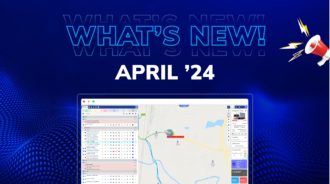In the fast-paced world of fleet management, ensuring the health of every component is crucial for achieving optimal efficiency and cost savings. One often overlooked aspect that significantly influences fleet performance is the condition of tires. In this blog post, we’ll delve into the profound impact tire health can have on overall fleet efficiency, supported by insightful statistics and real-world case studies. As we explore this, we’ll also connect these findings to the cutting-edge features offered by advanced tire monitoring software.
The Vital Connection Between Tire Health and Fleet Efficiency
Maintaining healthy tires is not just about preventing flats; it’s a strategic approach that directly influences the performance of an entire fleet. Let’s explore the key areas where tire health plays a pivotal role.
1. Fuel Efficiency and Tire Health
One of the most significant contributors to fleet operational costs is fuel consumption. According to recent studies, improperly inflated tires can lead to a 3-5% decrease in fuel efficiency. This seemingly small percentage can translate into substantial cost savings when applied across an entire fleet.
Connecting to Tire Health Monitoring Software Features:
- Real-time pressure monitoring capabilities can ensure that tires are always at the optimal pressure, maximizing fuel efficiency.
- Predictive analytics in tire monitoring software can alert fleet managers to potential issues before they impact fuel consumption.
2. Tire Wear and Maintenance Costs
Excessive tire wear not only impacts fuel efficiency but also results in higher maintenance costs. Regularly replacing worn-out tires can strain the fleet budget. Statistics show that fleets with proper tire maintenance programs experience up to 20% less spending on tire-related replacements.
Connecting to Tire Monitoring Features:
- Tire monitoring software provides real-time data on tread depth and wear patterns, allowing for proactive tire replacement scheduling.
- Predictive maintenance features can help fleet managers address tire issues before they become costly problems.
Trends in Tire Monitoring: Staying Ahead of the Curve
As technology continues to evolve, so does the landscape of tire health monitoring software. Understanding the current trends in tire monitoring is essential for fleet managers looking to stay ahead of the curve and maximize the benefits for their operations.
1. Integration with IoT and Telematics
Modern tire monitoring systems are increasingly integrating with IoT and telematics solutions. This integration allows for seamless communication between vehicles and centralized monitoring systems, providing real-time insights into tire health.
2. Artificial Intelligence for Predictive Maintenance
The use of artificial intelligence in tire monitoring is a game-changer. Predictive maintenance algorithms can analyze historical data and identify patterns, predicting when a tire is likely to fail.
Driving Fleet Efficiency Through Tire Health
The impact of tire health on fleet performance cannot be overstated. From fuel efficiency to maintenance costs, every aspect of fleet operations is intricately linked to the condition of the tires. As we move forward, embracing the trends in tire monitoring is key to unlocking even greater efficiency and cost savings.
By investing in advanced tire monitoring software, fleet managers can not only address current challenges but also position their fleets for a future where tire health is a proactive and data-driven aspect of overall performance optimization. Stay tuned to our blog for more insights into the evolving landscape of fleet management and tire monitoring trends.
Safety First: The Critical Link Between Tire Health and Road Safety
Beyond the economic impact, tire health plays a crucial role in ensuring road safety for fleets. According to the National Highway Traffic Safety Administration (NHTSA), tire-related issues contribute to a significant number of road accidents each year. Well-maintained tires are essential for preventing blowouts and maintaining vehicle stability, especially during adverse weather conditions.
Connecting to Tire Monitoring Features:
- Tire monitoring software with real-time alerts ensures that fleet managers are immediately notified of potential tire issues, allowing for swift intervention to prevent safety hazards.
- The ability to monitor tire temperature alongside pressure adds an additional layer of safety, helping prevent overheating and potential blowouts.
Environmental Considerations: Tires and Sustainable Fleet Management
In an era where sustainability is a top priority, the environmental impact of fleet operations cannot be ignored. Tires, when not properly maintained, contribute to increased fuel consumption and, consequently, higher carbon emissions. Addressing tire health directly aligns with eco-friendly fleet management practices.
Connecting to Tire Monitoring Features:
- Advanced tire monitoring software aids in optimizing tire pressure, reducing fuel consumption, and lowering the overall carbon footprint of a fleet.
- Comprehensive reporting features allow fleet managers to track and analyze the environmental impact of their operations, supporting sustainability initiatives.
Evolving Challenges: Adapting to Changing Road Conditions
As fleets operate in diverse environments, from highways to off-road terrains, the challenges faced by tires evolve. Understanding and adapting to changing road conditions is essential for maintaining tire health and overall fleet performance.
Connecting to Tire Monitoring Features:
- Tire monitoring software equipped with GPS and geofencing capabilities enables fleets to adjust tire maintenance strategies based on the specific conditions of the routes they traverse.
- The software’s data analysis features assist in identifying trends related to tire wear in different geographical areas, facilitating targeted maintenance efforts.
Beyond Numbers: The Human Element of Tire Health Management
While statistics and case studies provide valuable insights, it’s essential to recognize the human element in tire health management. Empowering drivers with knowledge and tools to monitor tire health fosters a proactive culture within the fleet, leading to improved overall performance.
Connecting to Tire Monitoring Features:
- User-friendly interfaces in tire monitoring software make it accessible for drivers to understand and act upon real-time tire data.
- Gamification elements, such as performance dashboards and rewards for adherence to tire maintenance best practices, encourage drivers to actively participate in preserving tire health.
The Future Roadmap: Innovations in Tire Monitoring Software
Looking ahead, the future of tire monitoring software holds exciting possibilities. Fleet managers can anticipate even more sophisticated features that further enhance performance, efficiency, and cost savings.
Connecting to Tire Monitoring Features:
- Exploring emerging technologies such as blockchain for secure and transparent tire data management within the fleet.
- Integration with autonomous vehicle systems, where tire monitoring becomes an integral part of the vehicle’s self-diagnostic capabilities.
In Summation: Driving Toward a Holistic Fleet Management Approach
In the complex world of fleet management, the impact of tire health on overall performance is multifaceted. From economic considerations and safety implications to environmental responsibility, tire maintenance forms the bedrock of a successful and sustainable fleet.
By embracing the trends in Tire health monitoring software and leveraging advanced solutions, fleet managers can navigate these challenges with confidence. As the industry continues to evolve, staying informed about the latest innovations in tire health management will be the key to maintaining a competitive edge in the dynamic landscape of fleet operations. Drive safe, drive efficiently, and stay tuned for more insights on optimizing your fleet’s performance.
FAQS
1. Why is tire health crucial for fleet performance?
Answer: Tire health directly influences fuel efficiency, maintenance costs, road safety, and environmental impact. Well-maintained tires contribute to optimal fleet performance and cost savings.
2. How do improperly inflated tires affect fuel efficiency?
Answer: Improperly inflated tires can lead to a 3-5% decrease in fuel efficiency. When tires are underinflated, the rolling resistance increases, resulting in higher fuel consumption.
3. What role does tire wear play in maintenance costs?
Answer: Excessive tire wear contributes to higher maintenance costs as worn-out tires need more frequent replacements. Proper tire maintenance programs can lead to significant cost savings.
4. How does tire health impact road safety for fleets?
Answer: Well-maintained tires are crucial for preventing blowouts and maintaining vehicle stability, ensuring road safety for both drivers and other road users.
5. Can tire monitoring software prevent safety hazards?
Answer: Yes, tire monitoring software with real-time alerts can promptly notify fleet managers of potential tire issues, allowing for swift intervention to prevent safety hazards.
6. What environmental considerations are associated with tire health?
Answer: Tires, when not properly maintained, contribute to increased fuel consumption and higher carbon emissions. Addressing tire health aligns with eco-friendly fleet management practices.
7. How does tire monitoring software contribute to sustainability?
Answer: Advanced tire monitoring software optimizes tire pressure, reduces fuel consumption, and lowers the overall carbon footprint of a fleet, contributing to sustainable fleet management.
8. How can fleets adapt to changing road conditions for tire health?
Answer: Tire monitoring software with GPS and geofencing capabilities enables fleets to adjust tire maintenance strategies based on the specific conditions of the routes they traverse.
9. How can drivers actively participate in tire health management?
Answer: User-friendly interfaces in tire monitoring software empower drivers with real-time tire data. Gamification elements, such as performance dashboards and rewards, encourage drivers to adhere to tire maintenance best practices.
10. What innovations can be expected in tire monitoring software in the future?
Answer: The future of tire monitoring software may include technologies like blockchain for secure tire data management and integration with autonomous vehicle systems for advanced self-diagnostic capabilities.
11. How does tire monitoring software enhance overall fleet performance?
Answer: Tire monitoring software enhances overall fleet performance by providing real-time data, enabling proactive maintenance, reducing downtime, and contributing to cost savings and operational efficiency.



